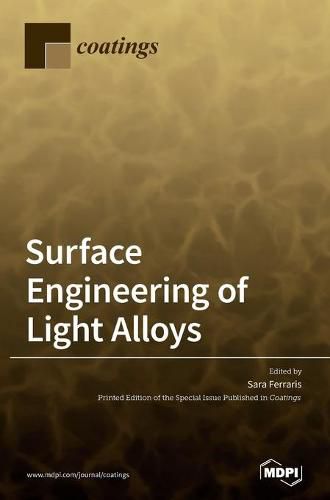Readings Newsletter
Become a Readings Member to make your shopping experience even easier.
Sign in or sign up for free!
You’re not far away from qualifying for FREE standard shipping within Australia
You’ve qualified for FREE standard shipping within Australia
The cart is loading…






This title is printed to order. This book may have been self-published. If so, we cannot guarantee the quality of the content. In the main most books will have gone through the editing process however some may not. We therefore suggest that you be aware of this before ordering this book. If in doubt check either the author or publisher’s details as we are unable to accept any returns unless they are faulty. Please contact us if you have any questions.
Light alloys (aluminum, magnesium, and titanium alloys) are gaining increasing interest in the scientific and technological community in many different application fields, from automotive to medicine, thanks to their light weight coupled with interesting mechanical properties. The functional performances of light alloys can be significantly affected by their surface properties; in fact, the surface can be considered as the visiting card of the material for its working environment (e.g., it can drive the biological response upon implantation for titanium alloys intended for biomedical implants or it can affect the joining ability of aluminum and magnesium alloys) as well as for its further material working steps (e.g., coatings). Surface engineering is a versatile tool for the modification of material surfaces in order to tailor and improve their functional properties. The aim of the present Special Issue is to present the latest development in this field through research and review papers. In particular, the topics of interest include, but are not limited to, surface engineering of light alloys for biomedical applications, surface engineering of light alloys for joining and coatings applications, surface engineering of light alloys for corrosion protection, and surface engineering of light alloys for antibacterial/antifouling purposes.
$9.00 standard shipping within Australia
FREE standard shipping within Australia for orders over $100.00
Express & International shipping calculated at checkout
Stock availability can be subject to change without notice. We recommend calling the shop or contacting our online team to check availability of low stock items. Please see our Shopping Online page for more details.
This title is printed to order. This book may have been self-published. If so, we cannot guarantee the quality of the content. In the main most books will have gone through the editing process however some may not. We therefore suggest that you be aware of this before ordering this book. If in doubt check either the author or publisher’s details as we are unable to accept any returns unless they are faulty. Please contact us if you have any questions.
Light alloys (aluminum, magnesium, and titanium alloys) are gaining increasing interest in the scientific and technological community in many different application fields, from automotive to medicine, thanks to their light weight coupled with interesting mechanical properties. The functional performances of light alloys can be significantly affected by their surface properties; in fact, the surface can be considered as the visiting card of the material for its working environment (e.g., it can drive the biological response upon implantation for titanium alloys intended for biomedical implants or it can affect the joining ability of aluminum and magnesium alloys) as well as for its further material working steps (e.g., coatings). Surface engineering is a versatile tool for the modification of material surfaces in order to tailor and improve their functional properties. The aim of the present Special Issue is to present the latest development in this field through research and review papers. In particular, the topics of interest include, but are not limited to, surface engineering of light alloys for biomedical applications, surface engineering of light alloys for joining and coatings applications, surface engineering of light alloys for corrosion protection, and surface engineering of light alloys for antibacterial/antifouling purposes.